Oscar fish are among some of the most popular aquarium fish in the hobby.
Known as the water puppy, they grow fast, they grow big. And into a fish renowned for their vibrant personalities, tail wagging, and show-stopping appearance.
And even though taking care of them is pretty straight-forward, keeping Oscars does come with some strict requirements. So they don’t fit with everyone.
This guide will cover essential aspects of Oscar care, including tank requirements, diet, water conditions, and health management, to ensure your Oscars thrive.
Care Overview
Oscar Fish (astronotus ocellatus)
Key Characteristics
- Size: 14-16 inches (35-40cm)
- Life span: 10-15 years
- Temperament: Aggressive
- Tank Mates: Other Oscars or South American Cichlids
- Living Zone: Bottom-mid level
- Diet: carnivor
Water Parameters
- Temperature: 74°F – 81°F (23°C – 27°C)
- pH Level: 6.0 – 7.5
- Water Hardness: 5 – 20 dGH
- Ammonia: 0 ppm
- Nitrite: 0 ppm
- Nitrate: <40 ppm
Care Schedule
- Daily: Feed 1-2 meals, check temperature, observe health, equipment check
- Weekly: Water test. Water change 40-50%, vacuum substrate
Scientific Classification
- Kingdom: Animalia
- Phylum: Chordata
- Class: Actinopterygii
- Order: Cichliformes
- Family: Cichlidae
- Genus: Astronotus
- Species: A. ocellatus
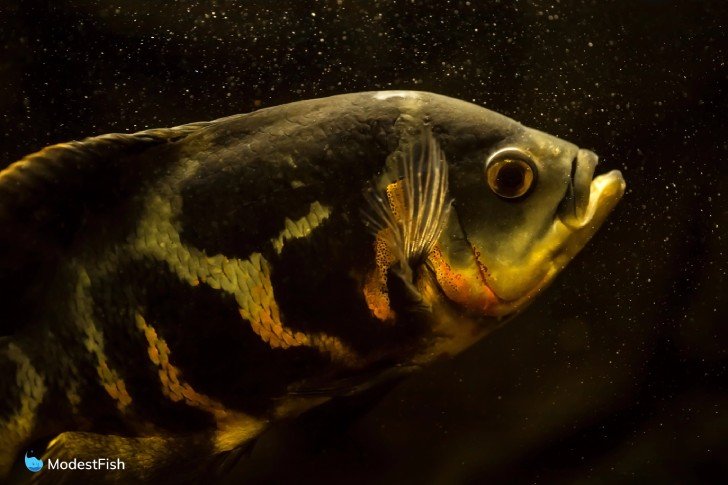
Tank Setup Overview
Tank Supplies
75 gallon tank (one oscar)
High powered canister or HOB filter
Heater
LED Lighting
Thermometer
Live plants (with caution)
Substrate
Decorations Decorations (with caution)
Water Conditioner
5 gallon bucket
API Master Test Kit
Algae scraper
Gravel vacuum
Diet
Fluval Bug Bites Cichlid Formula
Omega One Super Color Cichlid Pellets
Northfin Cichlid Pellets
Shrimp
Mussels
Tilapia filets (cut to size)
Clams
Earthworms
Table of Contents
Oscar Fish Species Profile Introduction
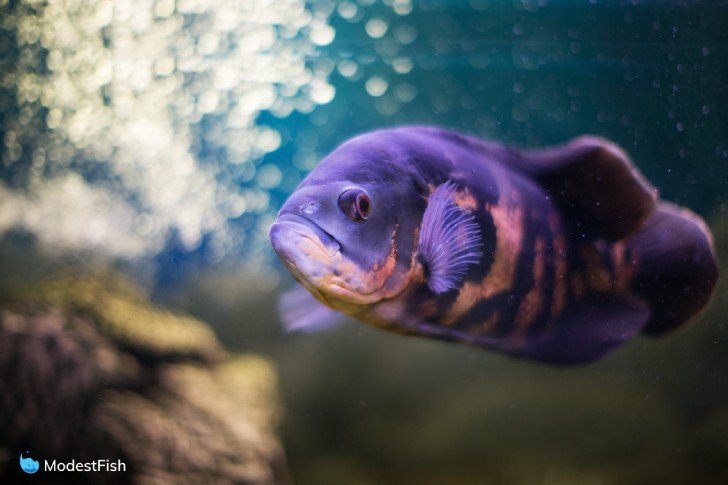
The oscar fish (astronotus ocellatus) is a South American species belonging to the cichlid family.
It’s native to many countries, including Peru, Ecuador, Brazil and Columbia. You can find oscar fish pretty much anywhere in the Amazon River Basin.
They typically live in low-flow, slow-moving white waters, which act as perfect hiding spots from predators- especially if there are greenery and branches.
As for their size:
They tend to grow to between 14-16 inches (35-40cm). Not small, ey?! But even more impressive than their size is the fact that they can grow super fast, sometimes at a rate of one inch per month!
Despite having types of oscars available, Oscar fish commonly found in the aquarium hobby are typically one of three variations: tiger oscars, red oscars, and albino oscars.
Tiger oscars are the most common breed; we generally consider them to be the ‘original’ oscar fish. They have red and orange patterns on top of a dark brown/gray base. They’re pure breeds, and because of this, possess the true characteristics and behaviors of typical oscar fish.
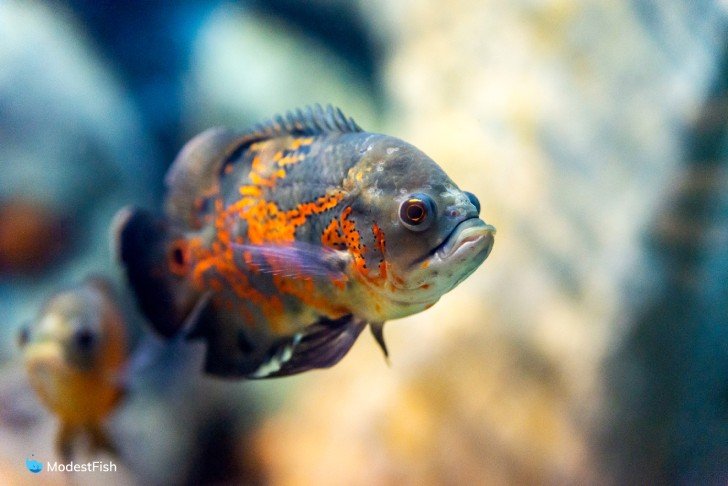
Red oscars are found in a variety of shades, from crimson and copper to rusty orange. Red oscars don’t have the markings or patterns characteristic of tiger breeds.
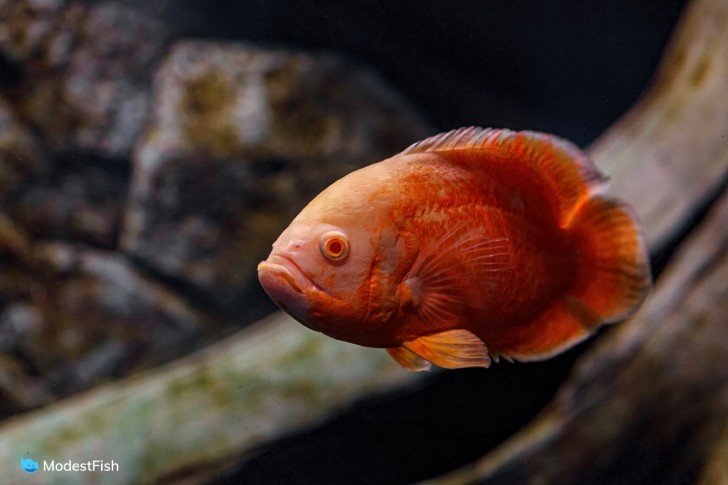
Alongside tiger oscars, red oscar fish are the most commonly kept breeds. Albino oscars are white in color and have shiny, velvety skin and red eyes. Lemon oscars are noteworthy, but rare. If you find some available, you’re in for a treat.
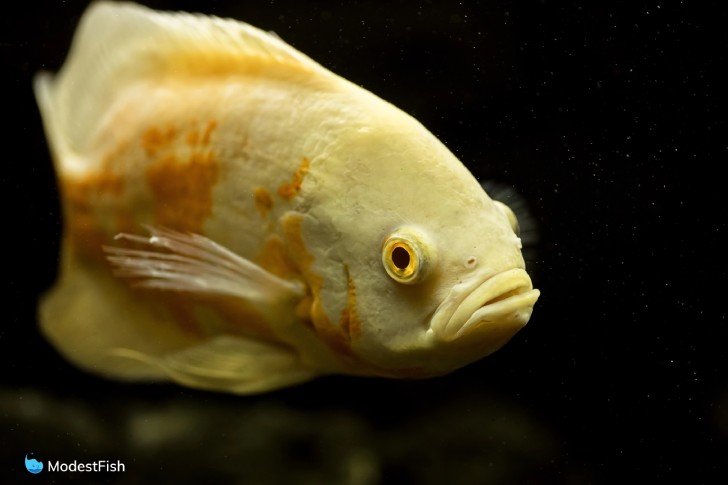
Oscar fish are normally pretty aggressive. But during breeding times? Multiply that by 100. Breeding makes oscar fish extremely territorial.
And as for their diets, they’re known for their voracious appetite and eagerness to consume anything small enough to fit inside their mouths.
Tank Setup Requirements
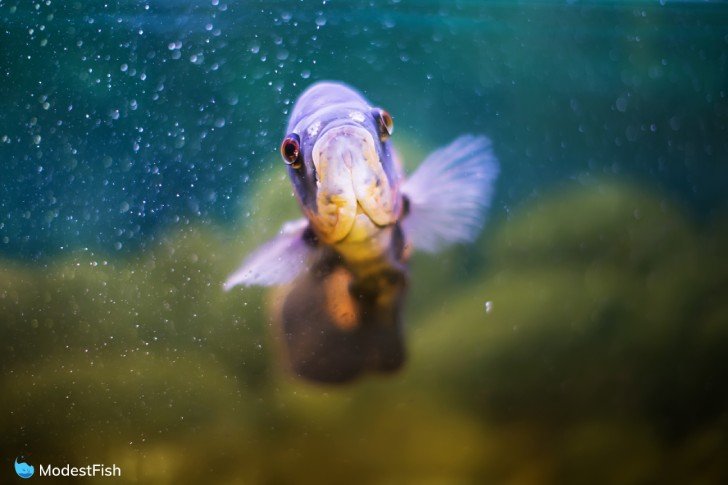
- 75 gallon tank (one oscar)
- Substrate
- High powered canister or HOB filter
- LED lighting
- Heater
- Live plants (with caution)
- Decorations (with caution)
Tank Size
Oscars grow fast, and they grow big. So your aquarium should be no smaller than 75 gallons (length 48 inches x width (depth) 18 inches x height 21 inches) . Even if it’s small when you buy it, it can grow up to 10 inches in one year.
Follow this rule of thumb for tank size:
- 1 Oscar – 75 gallons
- 2 Oscars – 125 gallons
- 3 Oscars – 150-200 gallons
But as we always say, bigger is always better. It’s easier to maintain a healthy environment in a larger body of water because any changes will have less of an impact. These minimum sizes may require maximum effort on your end.
Substrate
When it comes to housing oscar fish, both sand and gravel work well as substrates.
Oscars enjoy digging, as well as taking in and spitting out substrates (like sand). This can cause some filters to break, particularly if your oscar is projecting sand directly at filters.
Here’s the solution:
You can incorporate a pre-filter into your tank to prevent any damage from occurring even if you choose to use sand as a substrate.
That way, your oscar can dig up and spit out sand to his heart’s content and you don’t need to buy a new filter every 5 seconds. Win-win!
Filtration
Oscars are also very messy fish and have a large bioload/waste output. For that reason, oscars need fairly massive amounts of water filtration- with a focus on biofiltration.
Your filter needs to have a GPH rating 4 x greater than your tank size. So if you have the one oscar in a 75 gallon that’s a GPH rating of 300.
A canister filter or powerful hang-on-back (HOB) filter will be enough to take care of things. Some people also like to double up on filters.
After testing many different canister filters and HOB filters and would recommend the Fluval 407 canister and Seachem Tidal HOB as the best possible products for a large oscar fish tank.
Heating
If your tank is located in a room which maintains a stable temperature between 74°F – 81°F (23°C – 27°C), you may get away without adding any additional heater into the tank.
If you don’t live in this climate all year, get a reliable submersible heater with a guard and automatic shut-off. The guard will protect your oscar from burning if it touches it and the shut-off feature will stop it overheating if water levels drop.
When picking your heater, you can follow the general rule of 3-5 watts per gallon. A 75 gallon tank would then need a heater with 225-375 watts. After testing multiple heaters, I recommend the Fluval e-series. It won tests for safety, accuracy, and reliability.
Lighting
Oscar fish don’t need any specialist lighting. Simply keeping them in a standard room lit by daylight will work just fine.
But, if you fancy the idea of adding some lights to your aquarium, doing so won’t harm your fish. Many oscars prefer moderate-low lighting, so you shouldn’t leave your bulb on for more than 12 hours (if you keep it on too long, your fish might become agitated and distressed).
If you have an oscar that shies away when your bulb is on, then you may want to consider dimming your bulb (or removing it completely).
Wondering how you dim the bulb? It’s super simple:
Just poke holes into a piece of tin foil and wrap it around the bulb. The fewer holes, the dimmer your light will be.
Plants & Decorations
Keep it sparse with Oscar fish. Known for their tendency to rearrange their territories; if you pay attention, you’ll often see them moving small objects around their habitat.
You should avoid any breakable decorations, like ceramic objects.
If you have real plants inside the tank, the most likely outcome is that your oscar will tear them up a bit (if not totally destroy them), so fake plants and sturdy decorations like PVC pipes and stone caves are your best option.
Seriously, you’ve gotta prepare for destruction; these little dudes are reckless!
Oscars are also clumsy; they move around a lot and are constantly bashing into things. As hilarious as that sounds (and in reality, kinda’ is), there is a serious point to it:
You should probably avoid adding anything to your tank that has sharp edges or rough textures (like volcanic rocks).
Water Parameters

Oscar fish are hardy, and can tolerate a wide range of parameters. Stability and consistency is always key here.
- Temperature: 74°F – 81°F (23°C – 27°C)
- pH Level: 6.0 – 7.5
- Water Hardness: 5 – 20 dGH
- Ammonia: 0 ppm
- Nitrite: 0 ppm
- Nitrate: <40 ppm
In order to achieve these safe water parameters, you must cycle your tank. This is the process of establishing beneficial bacteria in the tank. You can read how to cycle your aquarium here.
Feeding
In the wild, oscars enjoy eating insects, smaller fish, worms, plants, berries- and in truth, they’ll eat any fruit that lands in their habitat. Their teeth are located by their gills, which is why they’re such messy eaters.
Therefore, feed your oscar a high-quality, high-protein diet with a variety of processed, frozen and freeze-dried foods.
A high-protein commercial fish food produced for carnivorous species (such as cichlid pellets) will be enough. These should comprise 80% of your oscar’s diet.
- Fluval Bug Bites Cichlid Formula – made from black soldier fly larvae, this high protein food mimics the insects Oscars would naturally eat
- Omega One Super Color Cichlid Pellets – salmon is the main ingredient in this food and it has added ingredients like whole shrimp and marigold extract that can help bring out your Oscar’s red color
- Northfin Cichlid Pellets – this food features whole Antarctic krill as the first ingredient, another food that yields high protein and brings out red coloration
This species will gladly munch on flake food, but they’re so messy, they usually leave behind tons of little pieces that end up rotting in the tank.
You should supplement the rest of your fish’s diet with live, natural food. This may include:
- Shrimp
- Mussels
- Tilapia filets (cut to size)
- Clams
- Earthworms
You can also give your oscar dead prawns and shrimp, since they’re both high in fiber and vitamins. But since an oscar’s diet should mainly be made up of lean foods, you should avoid poultry and beef heart. But, you can offer it as the occasional treat.
Never use feeder fish. They’re notorious for carrying pests and diseases that can infect your oscar fish.
Maintenance Schedule
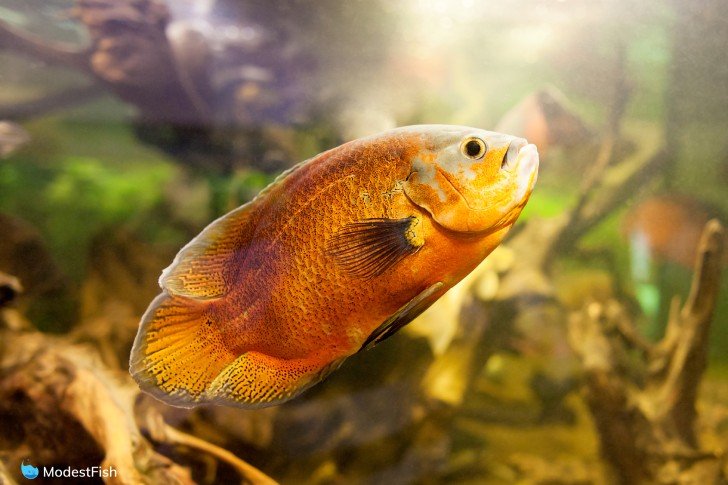
Equipment required:
- Fish food
- Thermometer
- Algae scraper
- API Master Test Kit
- Water Conditioner
- Gravel vacuum
- 5 gallon bucket
Daily tasks:
- Feed Oscars: Once or twice a day, depending on size and age.
- Check Water Temperature: Ensure it remains within the ideal range (74°F – 81°F or 23°C – 27°C).
- Observe Fish Health: Look for signs of stress, illness or aggression.
- Equipment Check: Ensure that filters, heaters, and other equipment are functioning properly.
Weekly tasks:
- Water Change: Change 40-50% of the tank water to reduce nitrate levels and remove detritus. For Oscars, more frequent or larger water changes may be necessary due to their large size and waste production.
- Test Water Parameters: Check pH, ammonia, nitrite, and nitrate levels to ensure they are within the appropriate ranges.
- Vacuum the Substrate: Remove food debris and fish waste to prevent ammonia and nitrite spikes.
Tank Mates

Oscars do best in a species only tank, simply because they’re highly aggressive and will eat anything that can fit in its mouth.
You can, however, keep other South American cichlids as tankmates, providing that these fish aren’t too aggressive or too passive.
But here’s the deal:
Aggressive fish will pick on those too passive, and a passive fish placed in a tank full of oscars will likely be bullied.
And if they don’t get bullied… they get eaten.
It’s a fish-eat-fish world out there!
Oscar fish are known for eating anything small enough to fit into their mouth. Guppies and smaller fish are top of the hit list, so best off keeping them separate from any larger oscar fish.
Breeding Oscar Fish
Breeding oscar fish is possible, though it isn’t the easiest of tasks. Start by ensuring you know the difference between males and females.
How to Sex Oscar Fish
Sexing oscar fish can be difficult. They are monomorphic, meaning that both sexes are virtually identical in appearance.
There are, however, a couple of characteristic features of male and female oscar fish which can be found by looking closely at their genitals.
Females have an egg tube which retracts fully inside of them, while males have a single sharp spike used for fertilization.
Initiating the Breeding Process
In the wild, oscars prefer to breed during rainy seasons. To replicate these conditions in your aquarium, you’ll need to conduct 20-30% water changes every couple of days.
You can also lower your water temperature by a few degrees to help things along. Lastly, you can use a watering can to sprinkle ‘rain’ (dechlorinated water) on top of your aquarium for 5-10 minutes a few times per day.
You can also install filter spray bars above your water to replicate these conditions if you don’t actually want to go to the effort of doing it all manually.
Oscar Fish Common Health Issues
Oscar fish rarely get sick, though there are a number of illnesses that they are at risk of catching.
The most common of these is known as hole-in-the-head (HITH) disease. You’ll know your fish has contracted the disease if you see cavities and holes forming across your fish’s head and body.
As freaky as that sounds (and is), it’s also easy to prevent:
Hole-in-the-head disease is commonly caused by nutritional deficiencies in your fish’s diet. By following the dietary guidelines we went through above, you can easily avoid hole-in-the-head disease.
The next biggest culprit is bacteria:
Live feeder fish (such as goldfish) can also cause your fish to fall ill, since they often contain bacteria from settlements. If you feed your Oscar a safe and quality diet, not feeder fish, you should avoid problems with HITH disease.
Are Oscar Fish Right For You?
If you can get a 75, 125, 150 gallon setup and can over filter with regular water changes, then I highly recommend oscar fish. They’re lovable rogues with tons of personality.
If you want to get into aquascaping and have a ton of plants and hardscape, Oscar fish aren’t for you.
I would recommend oscars to beginners and experienced aquarists as they’re very hardy and have the strength to pull through bigger mistakes. You just have to make sure you’re providing them with enough tank space and keep on top of water changes.
Oscar Fish FAQs
How long do Oscar Fish Live For?
Oscar fish can live for 10-15 years on average, however some have been known to live for up to 20 years when kept in highly maintained setups.
What do Oscar Fish Eggs Look Like?
Fertilized oscar eggs appear brown/tan in color, while unfertilized eggs are white.
Why do Oscar Fish Jump Out of the Tank?
Sometimes oscar fish will jump out of their tanks in an attempt to explore their surroundings or search for food. Additionally, they may attempt to escape from aquariums that are too small for them.
Keeping a lid on top of your aquarium will prevent your oscar from leaving its tank and coming to harm.
How Big Do Oscar Fish Grow?
A well looked after oscar fish can grow up to anywhere between 14-16 inches. Some have be documented at 18 inches.

I have albino fish,im worry to them b coz i think have problem in the eye, and didnt eat what i supposed to do?
Thank you for your comment, Sally. I’m sorry to say, but lots of albino animals (not just fish) can get eye problems, but without knowing all the details it’s hard for me to give you a response on this. As for the not eating, Oscar fish can be real picky when to comes to food, so you can try not feeding it for a few days and see if it starts again after that. You should also test your water conditions and make sure everything is where it should be.
I just bought a Oscar Fri. and haven’t been able to get him to eat anything I have pellets & flakes. I’m wondering if I’m not feeding him the right food or maybe it’s stressed from the change in his environment I also looking for some expert advice please and thank you!!
Hi Melissa, this answer is based on all your water parameters being suitable and stable:
Yes, it could just be your Oscar is taking time to adjust to its new environment. You can try not feeding it for 3 days and then offering food. You can also try asking your seller what food they were feeding the Oscar before. Sometimes they don’t understand new food is food and it can take some time to adjust because it may be used to eating one type of food.
Also, make sure you vacuum out all the food your Oscar refuses to eat after an hour or so. Otherwise this leftover food could negatively impact your tank’s ecosystem.
Thank you for the article . The tip about the light helped me alot . My new Oscars kept hiding and wh but when I dimmed the light they decided to come out to play 🙂 made my day
That’s so wonderful to hear, Taby. Wish you all the best
Can I do water changes with rain water
Hello Cindy, as long as you test the rain water and make sure it’s aquarium safe and fits your fish’s requirements, yes you can use rain water.
No, it can cause ph fluctuations
Hi Christopher, I was searching for a resourceful article on Oscar fish care. Thanks for the nice writing.
Hi Christopher, thank you so much for this article, it answered all the questions in my mind before asking any.
ModestFish thank you for giving us a great infrormation want to learn more in your articles
Thanks so much for that extremely informative article, Christopher. My wife just purchased 4 of them so it looks like I’m due to buy another aquarium. But that’s okay with me!
Just wanna tell about my Oscar’s we have 2 female tank mates they have always been together mostly get along but one has mood swings and gets we’ve watched it take all decor line across the tank front to back and about a foot in and not allow the other to cross the line I put it back shortly it would line it up again actually hilarious when it’s in its meanest moods bites at the glass if we point at it if its picking on the calmer one we can get its attention and motion it to go to other end of tank it will till it thinks we ain’t looking so it’s a repeat last time guess it was being a smart … cause it went back only not face first it backed up to the other end they r around 2 and it amazes me how smart they really r
Thank you soo mush for this information that i need because I wanted to start an oscar tank but I should buy a bigger tank because i only have a 25 gallon planted tank a 60 gallon cichlid tank and a few more but I should buy a 80 gallon tank if i want to get one now again thanks for the important information about oscar fish
I have three oscar. One of my Oscar always sit in the bottom of tanka. It’s activity is very low compare to othe oscar. But lucky it eats well than why it was always sit in the bottom